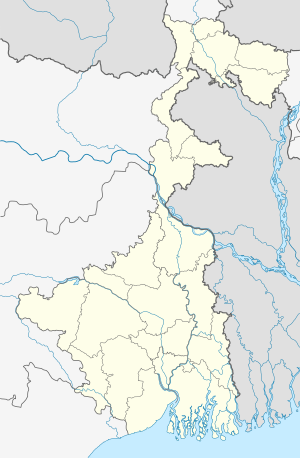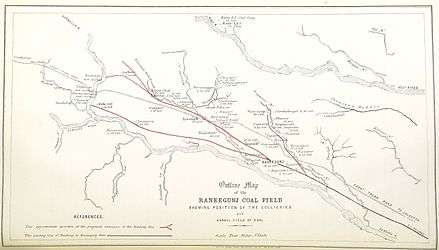Raniganj Coalfield
Raniganj Coalfield is primarily located in the Asansol and Durgapur subdivisions of Paschim Bardhaman district of West Bengal. It spreads over to the neighbouring districts of Birbhum, Bankura, Purulia and to Dhanbad district of Jharkhand.
| Location | |
|---|---|
 Raniganj Location in West Bengal | |
| State | West Bengal |
| Country | India |
| Coordinates | 23°37′44″N 87°06′54″E |
| History | |
| Opened | 1774 |
| Owner | |
| Company | Eastern Coalfields Limited |
| Website | http://www.easterncoal.gov.in/ |
| Year of acquisition | 1975 |
History

Coalmining in India first started in the Raniganj Coalfield. In 1774, John Sumner and Suetonius Grant Heatly of the British East India Company found coal near Ethora, presently in Salanpur community development block. The early exploration and mining operations were carried out in a haphazard manner.[1]
Regular mining started in 1820, led by an agency house, Alexander & Co. In 1835, Prince Dwarkanath Tagore bought over the collieries and Carr, Tagore and Company led the field. For the entire 19th century and a major part of the 20th century, Ranigunj coalfields was the major producer of coal in the country.[1]
At the behest of William Princep, Carr, Tagore and Company joined hands with Gilmore Hombray and Co. in 1843 to form Bengal Coal Company, which opened up coal mining activities. Their headquarters was at Sanctoria. Other mining companies included Birbhum Coal Co., Equitable Coal Co., Madhu Roy and Prasanna Dutta Co., Bird and Co., South Barakar Coal Co., Andrew Yule and Company Ltd. and Balmer Lawrie.[1][2]
In 1886, W.W.Hunter wrote, "Raniganj Coalfield has been estimated at an area of 500 square miles. In this ‘black country of India’, which is dotted with tall chimney stalks, many European companies are at work, besides many native firms. At first coal was raised from open workings; but regular mining is now carried on, according to the system known as ‘pillar and stall’… The miners are all drawn from the aboriginal races, chiefly Santals and Bauris, who are noted for their endurance and docility."[3]
Present status
All non-coking coal mines were nationalized in 1973 and placed under Coal Mines Authority of India. In 1975, Eastern Coalfields Limited, a subsidiary of Coal India Limited, was formed. It took over all the earlier private collieries in Raniganj Coalfield.[2]
Raniganj Coalfield covers an area of 443.50 km2 (171.24 sq mi) and has total coal reserves of 49.17 billion tonnes, spread across Indian states of West Bengal and Jharkhand.[2] That makes it the second largest coalfield in the country (in terms of reserves).[4] Out of the total reserve, 30.61 billion tonnes is in the West Bengal and 18.56 billion tonnes is in Jharkhand.
Coal seams
In the Raniganj Coalfield the coal seams can be divided into two blocks – Raniganj measures and Barakar measures. The following areas of ECL are covered by the Raniganj measures: Raniganj-Pandaveswar, Kajora, Jhanjra, Bankola, Kenda, Sonepur, Kunustoria, Satgram, Sripur, Sodepur and Salanpur (partly). Barakar measures cover two areas of ECL: Salanpur and Mugma.[2]
ONGC’s preliminary assessment of coal-bed methane indicates that four Damodar Valley coalfields – Jharia, Bokaro, North Karanpura and Raniganj – to be the most prospective.[5]
Performance Highlights
Raniganj Coalfield produces the best quality of non-coking coal in India, with average ash percentage of less than 20%. The main features of this coal are high volatile content, long flame, quick ignition and high heat value. The following are the highlights for fiscal year 2012-13:[2]
- Coal Production = 33.90 million tonnes
- Annual Turnover = ₹12,076.17 crore (US$1.7 billion)
- Profit Before Tax = ₹1,897.18 crore (US$270 million)
- Manpower = 72,973
- Number of operating mines = 98
- Number of underground mines = 77
- Number of opencast mines = 21
more
- Deocha Pachami coal block
References
- Akkori Chattopadhyay, Bardhaman Jelar Itihas O Lok Sanskriti , Vol I, pp. 46-51, Radical, 2001, ISBN 81-85459-36-3
- "Eastern Coalfields Limited". Eastern Coalfields Limited. Retrieved 14 July 2014.
- W.W.Hunter, The Indian Empire: Its People, History and Products, first published 1886, reprint 2005, Asian Educational Services, New Delhi, ISBN 81-206-1581-6
- "Coal Resources of india". geologydata.info. Retrieved 2008-08-31.
- "Coal Bed Methane" (PDF). CBM Potential in India. Eastern Coalfields Limited. Retrieved 2008-08-26.